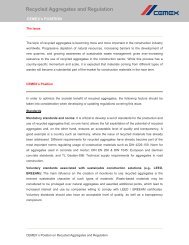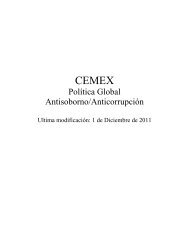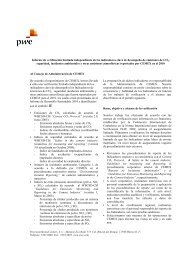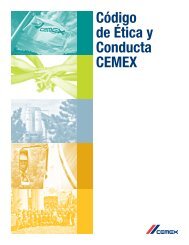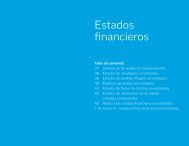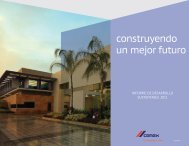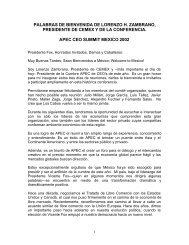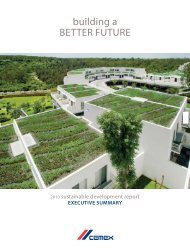building a STRONGER foundation - Cemex
building a STRONGER foundation - Cemex
building a STRONGER foundation - Cemex
You also want an ePaper? Increase the reach of your titles
YUMPU automatically turns print PDFs into web optimized ePapers that Google loves.
For the year ended December 31, 2009, we had a net loss of approximately Ps2.1 billion in the item “Results from financial<br />
instruments” as compared to a net loss of Ps15.2 billion in 2008. The loss in 2009 is mainly attributable to the currency derivatives we<br />
held and closed during the year, offset by the positive result from changes in market value of the equity derivatives remaining in our<br />
portfolio.<br />
Income Taxes. Our income tax effect in the statement of operations, which is primarily comprised of income taxes plus deferred<br />
income taxes, decreased from an income of Ps23.0 billion in 2008 to an income of Ps10.6 billion in 2009, mainly attributable to an<br />
increase in taxable earnings in our Mexican and South American operations. Our current income tax expense increased 9%, from<br />
Ps8.0 billion in 2008 to Ps8.7 billion in 2009. Our deferred tax benefit decreased from Ps31.0 billion in 2008 to Ps19.3 billion in 2009.<br />
The decrease was primarily attributable to the utilization of tax loss carryforwards during the period, the increases in the statutory<br />
income tax rate in Mexico from 28% to 30% in future periods, as well as the increase in valuation allowances relating to tax loss<br />
carryforwards. For the years ended December 31, 2008 and 2009, our statutory income tax rate was 28%. Our effective tax rate in<br />
2008 resulted in a tax rate of 101.0%, considering a loss before income tax of approximately Ps22.7 billion, while our effective tax<br />
rate in 2009 resulted in a tax rate of 227.7%, considering a loss before income tax of approximately Ps4.6 billion. See “Item 3 — Key<br />
Information — Risk Factors — The Mexican tax consolidation regime may have an adverse effect on cash flow, financial condition<br />
and net income.”<br />
Consolidated Net Income. For the reasons described above, our consolidated net income (before deducting the portion allocable<br />
to non-controlling interest) for 2009 decreased approximately Ps674 million, or 29%, from Ps2.3 billion in 2008 to Ps1.6 billion in<br />
2009. As a percentage of revenues, consolidated net income remained flat at approximately 1% in 2008 and 2009.<br />
Controlling Interest Net Income. Controlling interest net income represents the difference between our consolidated net income<br />
and non-controlling interest net income, which is the portion of our consolidated net income attributable to those of our subsidiaries in<br />
which non-associated third parties hold interests. Controlling interest net income decreased by approximately 38%, from Ps2.3 billion<br />
in 2008 to Ps1.4 billion in 2009. As a percentage of revenues, controlling interest net income remained flat in 2009 compared to 2008.<br />
Non-controlling Interest Net Income. Changes in non-controlling interest net income in any period reflect changes in the<br />
percentage of the stock of our subsidiaries held by non-associated third parties as of the end of each month during the relevant period<br />
and the consolidated net income attributable to those subsidiaries. Non-controlling interest net income increased substantially, from<br />
Ps45 million in 2008 to Ps240 million in 2009, mainly as a result of a significant increase in the net income of the consolidated entities<br />
in which others have a non-controlling interest. As a result, the percentage of our consolidated net income allocable to non-controlling<br />
interests increased from 2% in 2008 to 15% in 2009.<br />
Liquidity and Capital Resources<br />
Operating Activities<br />
We have satisfied our operating liquidity needs primarily through operations of our subsidiaries and expect to continue to do so<br />
for both the short and long-term. Although cash flow from our operations has historically met our overall liquidity needs for<br />
operations, servicing debt and funding capital expenditures and acquisitions, our subsidiaries are exposed to risks from changes in<br />
foreign currency exchange rates, price and currency controls, interest rates, inflation, governmental spending, social instability and<br />
other political, economic and/or social developments in the countries in which they operate, any one of which may materially reduce<br />
our net income and cash from operations. Consequently, in order to meet our liquidity needs, we also rely on cost-cutting and<br />
operating improvements to optimize capacity utilization and maximize profitability, as well as borrowing under credit facilities,<br />
proceeds of debt and equity offerings, and proceeds from asset sales. Our consolidated net cash flows provided by operating activities<br />
from continuing operations were approximately Ps38.5 billion in 2008, Ps33.7 billion in 2009 and Ps21.8 billion in 2010. See our<br />
Statement of Cash Flows included elsewhere in this annual report.<br />
Sources and Uses of Cash<br />
Beginning in 2008, the new MFRS B-2, Statement of Cash Flows (“MFRS B-2”), established the incorporation of a new cash<br />
flow statement, included elsewhere in this annual report, which presents cash inflows and outflows in nominal currency as part of the<br />
basic financial statements, replacing the statement of changes in financial position, which included inflation effects and foreign<br />
exchange effects not realized.<br />
Our review of sources and uses of resources presented below refers to nominal amounts included in our statement of cash flows<br />
for 2008, 2009 and 2010.<br />
109



